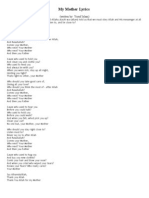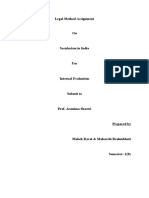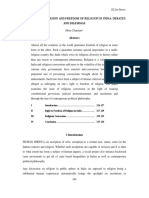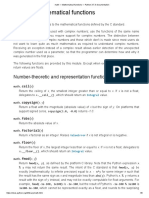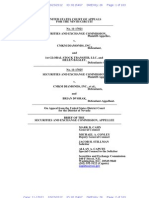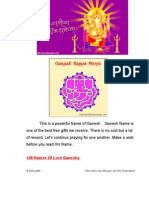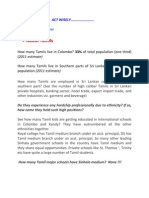Religious Freedom in India - Ankit Mohanty
Religious Freedom in India - Ankit Mohanty
Uploaded by
ankitmaanuCopyright:
Available Formats
Religious Freedom in India - Ankit Mohanty
Religious Freedom in India - Ankit Mohanty
Uploaded by
ankitmaanuCopyright
Available Formats
Share this document
Did you find this document useful?
Is this content inappropriate?
Copyright:
Available Formats
Religious Freedom in India - Ankit Mohanty
Religious Freedom in India - Ankit Mohanty
Uploaded by
ankitmaanuCopyright:
Available Formats
“Religious Freedom in India”
(This project work has been submitted towards the fulfilment of 1st Semester LLB)
SUBMITTED TO: MS SHREEM THITE
SUBMITTED BY: ANKIT MOHANTY
REGISTRATION NUMBER:
BATCH: LLB. (H) [1st SEMESTER]
Siksha ‘O’ Anusandhan National Institute of Law (SNIL)
SIKSHA ‘O’ ANUSANDHAN (Deemed to be University),
BHUBANESWAR
ABSTRACT
Religious freedom in India is a founda2onal aspect of its democra2c framework, guaranteed
by the Cons2tu2on. The country is home to a diverse array of faiths, fostering a rich tapestry
of cultural and spiritual tradi2ons. Despite this commitment, recent years have seen rising
concerns about religious intolerance and discrimina2on, with reports of violence and
harassment directed at various communi2es. These challenges raise cri2cal ques2ons about
the effec2veness of protec2ve measures for minority rights and the overall health of India’s
secularism. The ongoing discourse surrounding religious freedom remains vital for
maintaining the country's pluralis2c iden2ty and ensuring coexistence among its diverse
popula2on.
Religious Freedom in India 2
DECLARATION
I, Ankit Mohanty , hereby declare that this project report 2tled "Religious Freedom in India"
is the result of my independent work and has not been submiLed elsewhere for any academic
or professional purpose. All the sources consulted and references used in this report have
been duly acknowledged. Any assistance received in the prepara2on of this report has been
appropriately cited.
NAME: Ankit Mohanty
COURSE: LLB
DATE : 24 Oct 2024
Religious Freedom in India 3
ACKNOWLEDGEMENT
I express my sincere gra2tude to Ms Shreem Thite, whose guidance and support were
invaluable throughout the dura2on of this project. I am also thankful to SNIL for providing me
with the necessary resources and environment conducive to research. Furthermore, I extend
my apprecia2on to all those who contributed their insights and exper2se, directly or indirectly,
towards the comple2on of this project. Their assistance has been instrumental in shaping this
report.
NAME: Ankit Mohanty
COURSE: LLB
DATE : 24 Oct 2024
Religious Freedom in India 4
Table of Contents
INTRODUCTION.................................................................................................................. 6
LITERATURE REVIEW .......................................................................................................... 7
CHAPTERISATION ............................................................................................................... 9
Chapter 1: Introduc1on...............................................................................................................9
Chapter 2: Religious Demography ...............................................................................................9
Chapter 3 : Cons1tu1on Linkage ............................................................................................... 10
Chapter 4: Landmark Judgements ............................................................................................. 12
1. Bijoe Emmanuel v. State of Kerala, 1987 AIR 748 ..............................................................................12
2. Rev. Stainislaus v. State of Madhya Pradesh, (1977) 1 S.C.C. 677 ......................................................13
CONCLUSION .................................................................................................................... 14
BIBLIOGRAPHY ................................................................................................................. 14
Religious Freedom in India 5
INTRODUCTION
Religious freedom in India is fundamentally rooted in its Cons2tu2on, which guarantees the
right to prac2ce any religion freely. Hinduism, being the majority faith, plays a significant role
in shaping the country’s cultural and spiritual landscape. As a diverse and pluralis2c religion,
Hinduism encompasses a wide range of beliefs, prac2ces, and sects, contribu2ng to a rich
tapestry of tradi2ons. Fes2vals, rituals, and cultural prac2ces rooted in Hinduism are
celebrated across the na2on, reflec2ng the faith's deep integra2on into the social fabric of
Indian life. This diversity within Hinduism oVen promotes a sense of unity and coexistence
among various communi2es, highligh2ng its founda2onal principle of "Vasudhaiva
Kutumbakam" — the world is one family.
However, in recent years, there have been increasing concerns regarding the infringement of
religious freedom in India, par2cularly regarding the treatment of minority communi2es in
the context of a predominantly Hindu society. While many Hindus advocate for a harmonious
coexistence with all faiths, rising na2onalism has some2mes manifested in forms of
intolerance and violence. Reports of mob lynchings, the imposi2on of social restric2ons, and
the poli2ciza2on of religious iden22es have raised alarms about the poten2al erosion of the
secular principles that underpin Indian democracy. These developments pose significant
challenges not only to the rights of minority groups but also to the broader ideals of tolerance
and pluralism that are central to the country's iden2ty.
Religious Freedom in India 6
LITERATURE REVIEW
1. " A STUDY ON FREEDOM OF RELIGION IN INDIA " by Mrs. K.KALISELVI
Religion occupies a vital place in human lives. Gran2ng religious freedom permits different
beliefs, opinions, deduc2ons that people have in accordance to their own religion, to bloom
as well as develop in society . It plays an integral part in influencing the minds and convic2ons
of the people. It also plays an indispensable role especially in the Indian society in governing
the conduct as well as the behaviour of the people. Indians are extremely possessive when it
comes to their religion and they become alert as soon as any person tries to hinder it or
creates an obstacle in their journey of religious worship. Law gives all the Indian ci2zens the
sanc2on to prac2se this right in order to strengthen the harmony and oneness in the country,
but at the same 2me the state has the right to interfere when the abuse or any kind of wrong
usage of this right is projected in front of its eyes.
Right to freedom of religion is not only a right guaranteed by the cons2tu2on , but also at the
same 2me is a duty expected to be followed, for the beLerment and overall growth of the
society.
2. “2023 Report on InternaMonal Religious Freedom: India” by US Department of JusMce
The Report highlights significant concerns regarding the state of religious freedom and the
treatment of minority communi2es in the country. The report indicates an increase in
incidents of violence and discrimina2on, oVen aLributed to rising majoritarianism and the
influence of Hindu na2onalist groups. It details various challenges faced by religious
minori2es, including restric2ons on religious prac2ces, social ostracism, and incidents of mob
violence. Addi2onally, the report notes the impact of government policies and legisla2on that
dispropor2onately affect these communi2es, leading to a climate of fear and insecurity.
Overall, the findings underscore the urgent need for the Indian government to reinforce its
commitment to protec2ng religious freedom and ensuring equal rights for all ci2zens,
regardless of their faith.
3. The right to religious freedom is an individual right, but has a collec2ve dimension in that
the right extends to the manifesta2on of religion “in community with others' '. Thus groups of
believers and churches may complain about what they perceive as a viola2on of the rights to
associate and assemble for religious purposes. (Jenkins)
Religious Freedom in India 7
4. Religious freedom is premised on the belief that every human being has inherent dignity to
explore his or her conscience and pursue the truth. Religion is a code of ethical rules and that
the rituals, observances, ceremonies, and modes of worship are its outer manifesta2ons.
Religion also iden2fies with “feeling, emo2on and sen2ment, ins2nct, cult and ritual,
percep2on, belief and faith.” (Bielefeldt et al.)
Nature of Study: This study adopts a qualita2ve research approach, focusing on an in-depth
analysis of legal provisions, case studies, and expert opinions to gain insights into the
arbitra2on landscape in India.
Mode of CitaMon: The cita2on style followed in this project report adheres to the guidelines
of the relevant academic or ins2tu2onal standards, such as the Harvard referencing style or
any other specified format.
Religious Freedom in India 8
CHAPTERISATION
Chapter 1: Introduc1on
The right to religious freedom in India is a fundamental cons2tu2onal guarantee enshrined in
Ar2cle 25 of the Indian Cons2tu2on, which allows individuals to freely profess, prac2ce, and
propagate their religion. This provision reflects the country’s commitment to secularism and
pluralism, recognizing the diverse tapestry of faiths that coexist within its borders. Despite this
cons2tu2onal protec2on, the prac2cal realiza2on of religious freedom has faced challenges,
including rising communal tensions and incidents of violence against minority communi2es.
Debates around legisla2ve measures and social dynamics oVen raise concerns about the
extent to which the right to religious freedom is upheld in prac2ce. Nevertheless, the ongoing
discourse on this issue highlights the importance of safeguarding individual rights and
promo2ng harmony among India’s various religious communi2es.
Chapter 2: Religious Demography
The U.S. government es2mates India’s total popula2on at 1.4 billion as of mid-2023. According
to the 2011 na2onal census, the latest year with detailed figures, Hindus make up 79.8 percent
of the popula2on, while Muslims account for 14.2 percent, Chris2ans 2.3 percent, and Sikhs
1.7 percent. The World Religion Database provides a 2020 es2mate showing Hindus at 72.5
percent, Muslims at 14.5 percent, Chris2ans at 4.9 percent, Sikhs at 1.8 percent, and agnos2cs
at 1.2 percent. The 2011 census also iden2fies several groups cons2tu2ng less than 2 percent
of the popula2on, including Buddhists, Jains, Zoroastrians (Parsis), Jews, and Baha’is.
Addi2onally, the Ministry of Tribal Affairs recognizes over 104
Fig 1: Religious Demographic in India (2020)
Religious Freedom in India 9
million Scheduled Tribe members as Hindus—Indigenous groups historically outside the caste
system who oVen adhere to tradi2onal religious prac2ces—although approximately 10
millions of these Scheduled Tribe members are iden2fied as Chris2ans in the 2011 census.
Chapter 3 : Freedom of Religion in Cons1tu1on
The religious freedom of the individual person guaranteed by the Cons2tu2on of India is given
in clause (1) of ar2cle 25 that reads: Subject to public order, morality and health and to the
other provisions of this Part, all persons are equally en:tled to freedom of conscience and the
right freely to profess, prac:ce and propagate religion. In precise terms, the Cons2tu2on
makes it clear that the rights provided in clause (1) of ar2cle 25 are subject to public order,
morality and health and to the other provisions of Part III of the Cons2tu2on that lays down
Religious Freedom in India 10
the fundamental rights. Clause (2) of ar2cle 25 is a saving clause for the State so that the
religious rights guaranteed under clause (1) are further subject to any exis2ng law or a law
which the State deems it fit to pass that (a) regulates or lays restric2on on any economic,
financial, poli2cal or other secular ac2vity which may be associated with religious prac2ces,
or, (b) provides for social welfare and reform or the throwing open of Hindu religious
ins2tu2ons of a public character to all classes and sec2ons of Hindus.
Similarly Ar2cle 26 is the main ar2cle that provides the corporate freedom of religion
governing the rela2on between the State and Subject to public order, morality and health
every religious denomina2on or any sec2on thereof shall have the right,
(a) to establish and maintain ins2tu2ons for religious and charitable purposes; (b) to manage
its own affairs in maLers of religion; (c) to own and acquire movable and immovable property;
and (d) to administer such property in accordance with law. Clause (b) of ar2cle 26 guarantees
to every religious denomina2on or any sec2on thereof the right to manage its own affairs in
maLers of religion and clause (d) gives them the right to administer their property
(ins2tu2ons) in accordance with laws passed by the State. It is obvious from the language of
the clauses (b) and (d) of ar2cle 26 that there is an essen2al difference between the right of a
denomina2on to manage its religious affairs and its right to manage its property.
This means that a religious denomina2on’s right to manage its religious affairs is a
fundamental right protected by the Cons2tu2on. No legisla2on can violate it except for health,
morality and public order. But the right to administer property associated with religion can be
exercised only “in accordance with law”. In other words, the State can regulate the
administra2on of religious property by way of validly enacted laws. Hence, in the exercise of
individual and corporate freedom of religion as guaranteed in ar2cles 25 and 26 of the
Cons2tu2on of India, it is necessary to understand the judicial defini2on of ‘religion’ as given
in ar2cle 25(1) and ‘maLers of religion’ as provided in ar2cle 26(b). To define religion for
judicial purposes has been an onerous job for the judiciary both in the Western countries and
in India.
Religious Freedom in India 11
Chapter 4: Landmark Judgements
These cases illustrate how the courts have upheld individuals' freedom of religion and belief,
reaffirming India's iden2ty as a secular, democra2c state. Each case addresses fundamental
aspects of religious freedom, whether for communi2es or individuals. They represent
significant legal baLles fought in Indian courts, highligh2ng the complexi2es and challenges
involved in safeguarding the right to religious freedom in the country.
1. Bijoe Emmanuel v. State of Kerala, 1987 AIR 748
This is a landmark case in Indian cons2tu2onal law concerning the issues of freedom of
religion and expression. The case involved three students who, on religious grounds, refused
to sing the na2onal anthem at their government school in Kerala in 1985. Their decision led
to disciplinary ac2ons, including expulsion. The students and their families contended that
their religion prohibited them from singing the anthem, claiming that this cons2tuted a
viola2on of their rights to freedom of religion and expression.
The central ques2ons in this case revolved around the validity of the students' expulsion under
the Preven2on of Insults to Na2onal Honour Act, 1971, and the Kerala Educa2on Act and
Rules, as well as whether it infringed upon their fundamental rights under Ar2cles 19(1) and
25 of the Indian Cons2tu2on. The High Court ini2ally dismissed the pe22on, ci2ng the Kerala
Educa2on Act and direc2ves that mandated strict adherence to the school’s code of conduct.
The case eventually progressed to the Supreme Court of India, which ruled that the school
authori2es’ expulsion of the students was arbitrary and violated their Fundamental Right to
Freedom of Conscience and Religion. The Court emphasized that this right encompasses not
only the holding of beliefs but also the expression and prac2ce of those beliefs.
“ArMcle 25 is an arMcle of faith in the ConsMtuMon., incorporated in recogniMon of the
principle that the real test of democracy is the ability of even an insignificant minority to
find its idenMty under the country’s ConsMtuMon. This has to be borne in mind in interpreMng
ArMcle 25”.
The students' decision to stand respecrully during the na2onal anthem demonstrates that
their refusal to sing it did not amount to disrespect. The Court further highlighted that Indian
tradi2ons, philosophies, and the Cons2tu2on all emphasize the importance of tolerance,
urging that this principle should not be compromised.
Religious Freedom in India 12
Ul2mately, the Supreme Court's ruling in Bijoe Emmanuel v. State of Kerala reaffirmed the
significance of the Right to Freedom of Conscience and Religion as a Fundamental Right under
the Indian Cons2tu2on. The judgment also underscored the responsibility of public
authori2es, including educa2onal ins2tu2ons, to uphold and protect this right, emphasizing
the need for any regula2ons governing its exercise to be reasonable and jus2fiable.
2. Rev. Stainislaus v. State of Madhya Pradesh, (1977) 1 S.C.C. 677
Rev Stanislaus vs. Madhya Pradesh, 1977 SCR (2) 611 is a case in which the Supreme Court of
India examined whether the fundamental right to prac2ce and propagate religion
encompasses the right to convert others. The Court ruled that the right to propagate does not
include the right to convert, thereby affirming the cons2tu2onal validity of laws enacted by
the Madhya Pradesh and Odisha legislatures that prohibit conversion through force, fraud, or
inducement.
The High Court, considering the arguments presented, ruled that the Madhya Pradesh Act and
the Madhya Pradesh Swatantraya Rules, 1969, were enacted solely to penalize and prevent
unlawful conversions of religion through force, fraud, or inducement, and thus do not violate
Ar2cle 25(1) of the Cons2tu2on of India. The Court emphasized that the Act promotes equality
and freedom for all, highligh2ng that sec2ons 3, 4, and 5(2) specifically establish equality and
religious freedom by prohibi2ng unlawful conversions. It clarified that Ar2cle 25(1) does not
grant an individual the right to convert to another religion but allows for the propaga2on of
one’s beliefs within reasonable restric2ons.
Addressing the second issue, the Court stated that the provisions in the Madhya Pradesh Act
are designed to maintain public order by preven2ng coercive or unlawful religious
conversions, as the absence of such regula2ons could lead to public disorder. The Court
referenced Ramjilal Modi v. State of U.P., which affirmed that rights under Ar2cles 25 and 26
are connected to public order, and also cited Arun Ghosh v. State of West Bengal, which noted
that disrup2ons affec2ng both individuals and the community cons2tute public disorder.
In conclusion, the Court noted that any aLempt to incite communal tensions based on claims
of "forcible" conversion could lead to fears of public disorder, impac2ng the en2re community.
Therefore, the challenged Acts align with Entry I of List II of the Seventh Schedule, aimed at
preven2ng disrup2ons to public order by regula2ng conversions in a manner that respects
Religious Freedom in India 13
communal sensibili2es. The two Acts do not regulate religion itself, and there is no basis for
asser2ng that they fall under Entry 97 of List I of the Seventh Schedule.
CONCLUSION
India has long been inherently secular, drawing from its ancient past to uphold cultural and
religious freedom. While the Western concept of secularism may not hold direct relevance to
the Indian context, the inclusion of the term "secular" in the Cons2tu2on symbolizes the
commitment of Indians to embrace diversity. Although cri2cisms of the Essen2al Prac2ces test
have validity, the immense religious diversity in India necessitates judicial interven2on in
controversial maLers, as leaving these issues solely to public discre2on could lead to
significant unrest. However, this test should be employed only in cases of serious concern
regarding viola2ons of established restric2ons, rather than to micromanage the relevance of
specific religious prac2ces.
The courts have strongly defended the autonomy of religious ins2tu2ons in their
establishment and management, and the state generally refrains from overly intrusive
regula2on of religious prac2ces, focusing instead on the commercial aspects for various
reasons. The collabora2ve boundaries established by the state, judiciary, and society at large
contribute to India's unique and successful embodiment of "unity in diversity," which fosters
democracy even in challenging circumstances.
BIBLIOGRAPHY
1. hLps://blog.ipleaders.in/an-analysis-of-the-madhya-pradesh-freedom-of-religion-act-
2021/
2. Madras Hindu Religious and Charitable Endowment Act, 1951 (Madras Act 19 of
1951).
3. 2023 Report on International Religious Freedom: India
4. Constitution of India
5. Religious Freedom in India: Sovereignty and (Anti) Conversion by Goldie Osuri
6. Manupatra.com
7. Livelaw.in
Religious Freedom in India 14
You might also like
- Political Science ProjectDocument13 pagesPolitical Science ProjectKunal Sharma86% (21)
- NAVSEA SW010-AD-GTP-010 TM Small Arms Special Warfare AmmunitionDocument376 pagesNAVSEA SW010-AD-GTP-010 TM Small Arms Special Warfare Ammunitionsergey62No ratings yet
- My Mother LyricsDocument1 pageMy Mother LyricsAnis ZarifahNo ratings yet
- The Legend of Lightning LarryDocument8 pagesThe Legend of Lightning LarryPauline Karen Macaisa-Concepcion100% (1)
- Jamia Millia Islamia Faculty of LawDocument12 pagesJamia Millia Islamia Faculty of LawAarav AnandNo ratings yet
- Secularism UCC AssignmentDocument6 pagesSecularism UCC Assignmentabhilasha210506No ratings yet
- LLM Thesis PDF Minority Group Hindu 3Document1 pageLLM Thesis PDF Minority Group Hindu 3pooja maheshwariNo ratings yet
- The Fragile Balance: Challenges To Secularism in IndiaDocument5 pagesThe Fragile Balance: Challenges To Secularism in IndiaRijul AgrawalNo ratings yet
- Article Religion and Crime - Shivalika VermaDocument7 pagesArticle Religion and Crime - Shivalika Vermasubscription.adityaverma233No ratings yet
- Secularism and Practice in IndiaDocument17 pagesSecularism and Practice in IndiaArun MozhiNo ratings yet
- A Study of Compatibility of Anti-Conversion Laws With Right To Freedom of Religion in IndiaDocument0 pagesA Study of Compatibility of Anti-Conversion Laws With Right To Freedom of Religion in IndiaILIResearchNo ratings yet
- A Project On: Submitted ToDocument21 pagesA Project On: Submitted ToSwatantraPandeyNo ratings yet
- Legal Method AssignmentDocument13 pagesLegal Method Assignmentmahek ravalNo ratings yet
- Secularism and Indian Politics: Name of The TopicDocument30 pagesSecularism and Indian Politics: Name of The TopicYogesh Madan DharanguttiNo ratings yet
- Constitution Team 1Document16 pagesConstitution Team 1Kushal M SNo ratings yet
- Anindita Gogoi Pol Sc. RPDocument20 pagesAnindita Gogoi Pol Sc. RPhelalNo ratings yet
- Secularism in IndiaDocument37 pagesSecularism in Indiaapi-3832446100% (1)
- Final Draft ConstDocument10 pagesFinal Draft ConstShivangi MayaramkaNo ratings yet
- Religious Conversion and Freedom of Religion in India: Debates and DilemmasDocument11 pagesReligious Conversion and Freedom of Religion in India: Debates and DilemmasSaurabh YadavNo ratings yet
- Religious Conversion and Freedom of Religion in India: Debates and DilemmasDocument11 pagesReligious Conversion and Freedom of Religion in India: Debates and DilemmasNasir AlamNo ratings yet
- Aism BGDocument12 pagesAism BGchnamita26No ratings yet
- Secularism India Uk UasDocument13 pagesSecularism India Uk UasVishwajeet KumarNo ratings yet
- Securalism and ChallengesDocument52 pagesSecuralism and ChallengesPrinsu SenNo ratings yet
- IntroductionDocument6 pagesIntroductionselvamochNo ratings yet
- SecularisationDocument5 pagesSecularisationyonishakohli25No ratings yet
- 59 North India Theological Students' Conference, 2024Document6 pages59 North India Theological Students' Conference, 2024CR Lalfakzuala MizoNo ratings yet
- Secularism Project A Study of Compatibility of Anti Conversion Laws With Right To Freedom NewDocument43 pagesSecularism Project A Study of Compatibility of Anti Conversion Laws With Right To Freedom Newletter2lalNo ratings yet
- Compatibility of Secularism in India: A Contested DiscourseDocument5 pagesCompatibility of Secularism in India: A Contested DiscourseinventionjournalsNo ratings yet
- Secularism in IndiaDocument10 pagesSecularism in IndiaSubhajit BeraNo ratings yet
- Indian Political ThoughtDocument7 pagesIndian Political ThoughtParvathy R NairNo ratings yet
- Asha Ananadkumar - Sociology - A017Document20 pagesAsha Ananadkumar - Sociology - A017Asha AnandkumarNo ratings yet
- SecularismDocument31 pagesSecularismIMRAN ALAM100% (2)
- IJCRT2103530Document8 pagesIJCRT2103530Sahana MathpatiNo ratings yet
- Secularism and Pluralism in Indian Democracy - Issues and ChallengesDocument14 pagesSecularism and Pluralism in Indian Democracy - Issues and Challengesbulbulswain929No ratings yet
- secularism1Document5 pagessecularism1paritosh punjNo ratings yet
- The Events of 1984Document12 pagesThe Events of 1984Mehak AgarwalNo ratings yet
- Aippm BGDocument24 pagesAippm BGMadhav BansalNo ratings yet
- Ramdev Bharadwaj - Indian Constitution and SecularismDocument19 pagesRamdev Bharadwaj - Indian Constitution and SecularismDr. Ram Dev Bharadwaj100% (1)
- Religion and Secularism: Sociology Tutorial-2Document5 pagesReligion and Secularism: Sociology Tutorial-2mohitprasad009No ratings yet
- Dissertation Synopsis: Student's Name: BHANWATIDocument7 pagesDissertation Synopsis: Student's Name: BHANWATIBhan WatiNo ratings yet
- Damodaram Sanjivayya National Law University Visakhapatnam, A.P., IndiaDocument22 pagesDamodaram Sanjivayya National Law University Visakhapatnam, A.P., IndiaKranthi TalluriNo ratings yet
- Secularism in India: A Myth or Reality: Sumbul FatimaDocument5 pagesSecularism in India: A Myth or Reality: Sumbul FatimaazharNo ratings yet
- Harshita Vatsayan, INDIA'S QUEST FOR SECULAR IDENTITY AND FEASIBILITY OF A UNIFORM CIVIL CODEDocument33 pagesHarshita Vatsayan, INDIA'S QUEST FOR SECULAR IDENTITY AND FEASIBILITY OF A UNIFORM CIVIL CODENikhil RanjanNo ratings yet
- Chapter V EditedDocument32 pagesChapter V EditedVictor Mane OfficialNo ratings yet
- (LLM. Crim.L) Comperative LawDocument11 pages(LLM. Crim.L) Comperative LawAishwarya SudhirNo ratings yet
- Secularism and Religious FanaticismDocument30 pagesSecularism and Religious FanaticismLawyer Chandresh TiwariNo ratings yet
- Christian Response To Conversion DebateDocument11 pagesChristian Response To Conversion DebateVivek SlpisaacNo ratings yet
- SecularismDocument17 pagesSecularismAman SheikhNo ratings yet
- SecularismDocument11 pagesSecularismWorkaholicNo ratings yet
- Family Law 1Document14 pagesFamily Law 1Tenzing NamgyalNo ratings yet
- ConstiDocument13 pagesConstiakhil SrinadhuNo ratings yet
- 4 SecularismDocument9 pages4 SecularismJaidi Singnar PatorNo ratings yet
- Damodaram Sanjivayya National Law University Visakhapatnam, A.P., IndiaDocument28 pagesDamodaram Sanjivayya National Law University Visakhapatnam, A.P., IndiaSuvedhya ReddyNo ratings yet
- Doctrine of Essential Religious PracticesDocument18 pagesDoctrine of Essential Religious Practices23mlc009No ratings yet
- secularism in indiaDocument9 pagessecularism in indiakeshavsaini4423No ratings yet
- Secularism and Communalism in India: Role of The State and The CitizensDocument6 pagesSecularism and Communalism in India: Role of The State and The CitizensPratistha SharmaNo ratings yet
- CCL-Kushagra Pandya - 19-61Document17 pagesCCL-Kushagra Pandya - 19-61Kushagra PandyaNo ratings yet
- SociologyDocument33 pagesSociologyTamannaNo ratings yet
- 270424110406File8TH CIVICS FA-1Document8 pages270424110406File8TH CIVICS FA-1famkmr11No ratings yet
- Sociology Project FinalDocument24 pagesSociology Project Finalvaibhav shuklaNo ratings yet
- The Wheel of Law: India's Secularism in Comparative Constitutional ContextFrom EverandThe Wheel of Law: India's Secularism in Comparative Constitutional ContextRating: 4.5 out of 5 stars4.5/5 (2)
- Anand RathiDocument35 pagesAnand RathiankitmaanuNo ratings yet
- Python 3.7.3 Documentation - Mathematical FunctionsDocument8 pagesPython 3.7.3 Documentation - Mathematical FunctionsankitmaanuNo ratings yet
- Free Data Science ResourcesDocument1 pageFree Data Science ResourcesankitmaanuNo ratings yet
- Faridabad Gurgaon Rohtak Hisar Panipat Karnal Sonipat Yamunanagar PanchkulaDocument4 pagesFaridabad Gurgaon Rohtak Hisar Panipat Karnal Sonipat Yamunanagar PanchkulaankitmaanuNo ratings yet
- Cooperative Movement: Subject-Rural DevelopmentDocument23 pagesCooperative Movement: Subject-Rural Developmentankitmaanu100% (1)
- Valuation 2nd SemDocument13 pagesValuation 2nd SemankitmaanuNo ratings yet
- Electrification DHENKANAL, ODISHADocument4 pagesElectrification DHENKANAL, ODISHAankitmaanuNo ratings yet
- Introduction To Urban GeoDocument2 pagesIntroduction To Urban GeoankitmaanuNo ratings yet
- Name Status District Populat Ion Populat Ion Populat Ion: Adampur Ambala Ambala CantonmentDocument10 pagesName Status District Populat Ion Populat Ion Populat Ion: Adampur Ambala Ambala CantonmentankitmaanuNo ratings yet
- Name Status District Populati On Populati On Populati On: FaridabadDocument5 pagesName Status District Populati On Populati On Populati On: FaridabadankitmaanuNo ratings yet
- Contract Performance Bank Guarantee (To Be Stamped in Accordance With Stamp Act)Document2 pagesContract Performance Bank Guarantee (To Be Stamped in Accordance With Stamp Act)ssat111No ratings yet
- An Open Letter To Law Enforcement Humans PDFDocument6 pagesAn Open Letter To Law Enforcement Humans PDFzigzag7842611100% (7)
- Taylor Swift Eras Tour Concert SetlistDocument3 pagesTaylor Swift Eras Tour Concert SetlistyuristiattNo ratings yet
- 1001 Movies You Must See Before You DieDocument35 pages1001 Movies You Must See Before You DieJosé HuertasNo ratings yet
- Tutorial Question - Burden & Standard of ProofDocument2 pagesTutorial Question - Burden & Standard of ProofdiannedensonNo ratings yet
- Free Press - Indore Epaper Edition - 16 Jan 2023Document25 pagesFree Press - Indore Epaper Edition - 16 Jan 2023Abhishekh GuptaNo ratings yet
- Decision: Court of AppealsDocument8 pagesDecision: Court of Appealsviktor samuel fontanillaNo ratings yet
- Case No. 12 - Administrative Regulations or DecisionsDocument1 pageCase No. 12 - Administrative Regulations or DecisionsJeandee LeonorNo ratings yet
- Dvorak Mar 23Document103 pagesDvorak Mar 23glimmertwins100% (1)
- SODocument2 pagesSOMa Janelli Erika AguinaldoNo ratings yet
- Consumer CaseDocument10 pagesConsumer CaseANo ratings yet
- Keleher, Serge. Out of The Catacombs: The Greek-Catholic Church in UkraineDocument13 pagesKeleher, Serge. Out of The Catacombs: The Greek-Catholic Church in UkrainekumbhandaNo ratings yet
- Hindu Nationalist Exposes RSS, VHP & SANGH PARIVARDocument17 pagesHindu Nationalist Exposes RSS, VHP & SANGH PARIVARhindu.nation100% (1)
- Pink Cute Aesthetic Group Project PresentationDocument10 pagesPink Cute Aesthetic Group Project PresentationNorfa NordinNo ratings yet
- Superheroes - Passive Voice GameDocument1 pageSuperheroes - Passive Voice Gameaeprahman2023No ratings yet
- BSCI Code of ConductDocument18 pagesBSCI Code of ConductBalakrishnan NandhakumarNo ratings yet
- Fabian Anuar MailDocument7 pagesFabian Anuar MailAlias IbrahimNo ratings yet
- Config CFGDocument4 pagesConfig CFGvictorvulpe91No ratings yet
- 108 Names of GaneshDocument6 pages108 Names of GaneshprashantguptaNo ratings yet
- Administrative Law (2021)Document3 pagesAdministrative Law (2021)Mudit BansalNo ratings yet
- Waldowski, Walter Koscuisko (Painless Pole)Document1 pageWaldowski, Walter Koscuisko (Painless Pole)Baloo Nick CastlesNo ratings yet
- Rutakangwa Ja Execution Decree Proper Procedures SaleDocument50 pagesRutakangwa Ja Execution Decree Proper Procedures SaleMarco kusyamaNo ratings yet
- RappellingDocument114 pagesRappellingGaribaldi PerrusiNo ratings yet
- Richards Vindictive Prosecution MotionDocument71 pagesRichards Vindictive Prosecution MotionSlate magazineNo ratings yet
- October 18 2013Document8 pagesOctober 18 2013thestudentageNo ratings yet
- Unpublished United States Court of Appeals For The Fourth CircuitDocument3 pagesUnpublished United States Court of Appeals For The Fourth CircuitScribd Government DocsNo ratings yet
- Tamils Pissing On SinhaleseDocument6 pagesTamils Pissing On SinhaleseBauddha Kandaayama0% (1)


